最新初中英语名词经典教案
教学英语名词教案模板范文
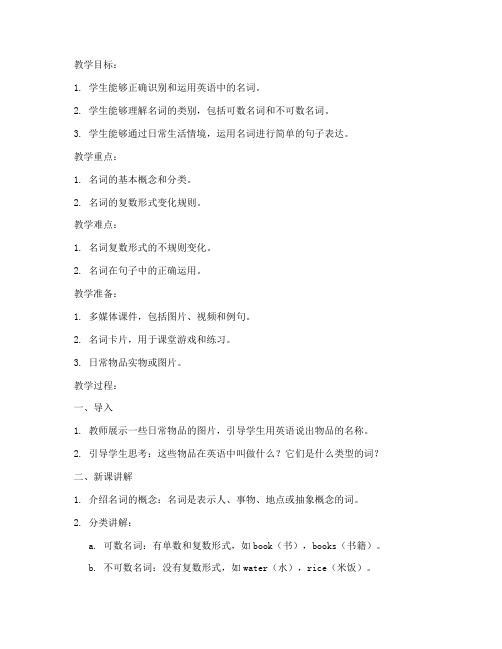
教学目标:1. 学生能够正确识别和运用英语中的名词。
2. 学生能够理解名词的类别,包括可数名词和不可数名词。
3. 学生能够通过日常生活情境,运用名词进行简单的句子表达。
教学重点:1. 名词的基本概念和分类。
2. 名词的复数形式变化规则。
教学难点:1. 名词复数形式的不规则变化。
2. 名词在句子中的正确运用。
教学准备:1. 多媒体课件,包括图片、视频和例句。
2. 名词卡片,用于课堂游戏和练习。
3. 日常物品实物或图片。
教学过程:一、导入1. 教师展示一些日常物品的图片,引导学生用英语说出物品的名称。
2. 引导学生思考:这些物品在英语中叫做什么?它们是什么类型的词?二、新课讲解1. 介绍名词的概念:名词是表示人、事物、地点或抽象概念的词。
2. 分类讲解:a. 可数名词:有单数和复数形式,如book(书),books(书籍)。
b. 不可数名词:没有复数形式,如water(水),rice(米饭)。
3. 讲解名词复数形式的变化规则:a. 一般规则:在名词后加上-s或-es,如cat(猫),cats(猫们)。
b. 特殊规则:不规则变化,如man(男人),men(男人);child(孩子),children(孩子们)。
三、课堂练习1. 教师出示名词卡片,学生根据卡片上的名词进行分类,可数名词和不可数名词。
2. 学生进行小组讨论,列举出自己熟悉的可数名词和不可数名词。
3. 教师播放相关视频或音频,学生根据视频或音频内容填写缺失的名词。
四、课堂游戏1. “名词接龙”游戏:学生依次说出一个名词,下一个学生说出以该名词最后一个字母开头的名词。
2. “寻找物品”游戏:教师出示一张图片,学生根据图片内容,用英语说出图片中物品的名称。
五、总结与拓展1. 教师总结本节课所学内容,强调名词的分类和复数形式变化规则。
2. 学生思考并分享:名词在日常生活和学习中的重要性。
3. 布置作业:让学生收集自己感兴趣的名词,并尝试用英语进行描述。
初中英语语法名词教案

初中英语语法——名词教案教学目标:1. 让学生掌握名词的分类和用法。
2. 培养学生正确运用名词进行表达的能力。
3. 提高学生对英语语法的兴趣和自信心。
教学内容:1. 名词的分类:可数名词、不可数名词、专有名词。
2. 名词的复数形式。
3. 名词所有格的用法。
教学步骤:一、导入(5分钟)1. 老师向学生介绍本节课的主题:名词。
2. 学生通过思考和讨论,分享他们对名词的了解。
二、讲解(15分钟)1. 老师讲解名词的分类:可数名词、不可数名词、专有名词。
2. 老师举例说明名词的复数形式的变化规则。
3. 老师讲解名词所有格的用法,并通过例句进行演示。
三、练习(10分钟)1. 学生完成一份关于名词的练习题,检验自己对名词的理解。
2. 老师挑选几位学生的练习进行点评,纠正错误并讲解原因。
四、小组活动(10分钟)1. 学生分成小组,讨论并总结名词的用法。
2. 每个小组选一位代表进行汇报,其他小组成员补充。
五、总结(5分钟)1. 老师引导学生回顾本节课所学内容,总结名词的分类、复数形式和所有格的用法。
2. 学生分享自己在课堂上的收获和感受。
教学评价:1. 通过课后作业和测试,检查学生对名词知识的掌握程度。
2. 观察学生在课堂上的参与度和小组活动中的表现,评估他们的学习效果。
六、案例分析与应用(10分钟)1. 老师展示一些含有名词的句子,让学生识别并解释其中的名词。
2. 学生分析句子中名词的作用和语法功能。
3. 老师引导学生运用所学知识,分析并解决实际生活中的名词用法问题。
七、拓展训练(10分钟)1. 学生完成一份关于名词的拓展练习,巩固所学知识。
2. 老师挑选几位学生的练习进行点评,纠正错误并讲解原因。
3. 老师鼓励学生多进行名词的练习,提高自己的语法水平。
八、课堂小结(5分钟)1. 老师引导学生回顾本节课的学习内容,总结名词的分类、复数形式和所有格的用法。
2. 学生分享自己在课堂上的收获和感受。
九、课后作业(布置作业)1. 学生完成一份关于名词的课后作业,巩固所学知识。
初中英语名词课程教案模板

课程目标:1. 学生能够正确识别和区分名词的不同类别(可数名词、不可数名词、抽象名词等)。
2. 学生能够熟练运用名词进行句子构建,提高语言表达能力。
3. 学生能够通过名词学习,增强对英语词汇的记忆和应用能力。
教学对象:初中一年级学生教学时间:2课时教学准备:1. 教学课件2. 名词卡片3. 名词例句集4. 练习题教学过程:第一课时一、导入(10分钟)1. 通过展示图片或实物,引导学生说出相应的名词。
2. 提问:名词有哪些特点?它们在我们的生活中有哪些作用?二、新课讲解(30分钟)1. 名词的分类:a. 可数名词:可数名词是可以数数的名词,如:book, apple。
b. 不可数名词:不可数名词是不能数数的名词,如:water, milk。
c. 抽象名词:抽象名词是表示抽象概念的名词,如:love, freedom。
2. 名词的用法:a. 单数形式:名词的基本形式,如:a book, an apple。
b. 复数形式:名词的复数形式,如:books, apples。
c. 名词所有格:表示名词的所有关系,如:the teacher's book, mymother's apple。
三、课堂练习(20分钟)1. 学生根据所给名词,填写相应的复数形式。
2. 学生根据所给名词,构造简单的句子。
四、小结(5分钟)1. 回顾本节课所学的名词知识。
2. 强调名词在句子中的作用。
第二课时一、复习导入(10分钟)1. 学生回顾上节课所学的名词知识。
2. 教师提问:名词有哪些分类?它们有什么特点?二、巩固练习(30分钟)1. 学生完成名词卡片练习,识别名词的分类。
2. 学生完成名词例句集练习,判断名词的用法。
三、拓展活动(20分钟)1. 学生分组,每组准备一个名词主题,进行名词接龙游戏。
2. 学生展示自己的名词主题,并分享相关知识。
四、课堂小结(5分钟)1. 教师总结本节课所学内容。
2. 强调名词在实际生活中的应用。
初中英语名词专题教案

初中英语名词专题教案一、教学目标:1. 让学生掌握名词的分类,包括可数名词、不可数名词、名词所有格等。
2. 让学生能够正确使用名词进行句子构建,并能够运用名词进行简单的表达。
3. 培养学生对英语名词用法的兴趣,提高学生的英语语法水平。
二、教学内容:1. 可数名词与不可数名词的区分及用法。
2. 名词所有格的用法。
3. 名词在句子中的作用,如主语、宾语、表语等。
三、教学重点与难点:1. 重点:名词的分类及其在句子中的基本用法。
2. 难点:名词所有格的用法及名词在句子中的不同角色。
四、教学方法:1. 采用任务型教学法,让学生在实践中学习和掌握名词的用法。
2. 运用分组讨论法,激发学生的思维,提高学生的参与度。
3. 采用案例分析法,通过具体例子让学生理解名词的用法。
五、教学步骤:1. 导入:通过图片展示,引导学生谈论图片中的物品,引出名词的概念。
2. 新课内容:介绍可数名词与不可数名词的区分及用法,讲解名词所有格的用法。
3. 实例分析:分析一些含有名词的句子,让学生理解名词在句子中的不同角色。
4. 小组讨论:让学生分组讨论,运用所学名词知识进行句子构建。
5. 课堂练习:设计一些练习题,让学生巩固所学知识。
六、教学活动:1. 复习上节课所学的名词知识,通过问答方式检查学生的掌握情况。
2. 进行一场小游戏,让学生在游戏中运用名词进行表达,增强学生的实践能力。
七、课堂练习:1. 设计一些练习题,包括选择题、填空题和改错题,让学生巩固所学知识。
2. 挑选一些学生的练习进行点评,指出其中的错误并提供正确答案。
八、拓展知识:1. 介绍一些与名词相关的语法点,如名词的数、格等。
2. 通过案例分析,让学生了解名词在复杂句子中的用法,提高学生的语法水平。
九、课后作业:1. 布置一些课后练习题,要求学生按时完成。
2. 鼓励学生在生活中多运用所学名词知识,提高学生的实际运用能力。
十、教学反思:2. 根据学生的反馈,调整教学方法,为下一节课的教学做好准备。
初中英语语法名词教案

初中英语语法——名词教案教学目标:1. 让学生掌握名词的分类和基本用法。
2. 培养学生正确运用名词进行表达的能力。
3. 提高学生对英语语法的兴趣和自信心。
教学内容:第一章:名词概述1.1 名词的定义1.2 名词的分类1.3 名词的数第二章:名词的格2.1 名词的单数格2.2 名词的双数格2.3 名词的复数格第三章:名词的所有格3.1 名词所有格的规则3.2 名词所有格的用法3.3 名词所有格与of结构的区别第四章:名词的修饰语4.1 形容词作定语4.2 副词作定语4.3 介词短语作定语第五章:名词的搭配关系5.1 名词与形容词的搭配5.2 名词与动词的搭配5.3 名词与介词的搭配教学过程:一、导入(5分钟)1. 引导学生回顾已学的词汇,如动物、植物、家庭成员等。
2. 提问:这些词汇在句子中是如何使用的?二、讲解(20分钟)1. 第一章:介绍名词的定义、分类和数。
a. 举例说明名词的分类:人物名词、地点名词、物质名词等。
b. 讲解名词的数:单数和复数。
c. 练习:填空、选择题。
2. 第二章:讲解名词的格。
a. 单数格、双数格和复数格的表示方法。
b. 举例说明名词格的变化规律。
c. 练习:填空、选择题。
3. 第三章:介绍名词的所有格。
a. 讲解名词所有格的规则。
b. 举例说明名词所有格的用法。
c. 对比名词所有格与of结构的区别。
d. 练习:填空、选择题。
4. 第四章:讲解名词的修饰语。
a. 介绍形容词、副词和介词短语作定语的用法。
b. 举例说明不同修饰语对名词的影响。
c. 练习:填空、选择题。
5. 第五章:讲解名词的搭配关系。
a. 举例说明名词与形容词、动词、介词的搭配。
b. 引导学生注意名词搭配的重要性。
c. 练习:填空、选择题。
三、练习(15分钟)1. 根据所学的知识点,完成练习题。
2. 学生互相批改,教师讲解答案。
四、总结(5分钟)1. 回顾本节课所学的内容。
2. 提问:名词在句子中的作用是什么?3. 提醒学生注意名词的搭配和修饰语的使用。
初中名词专题讲解教案
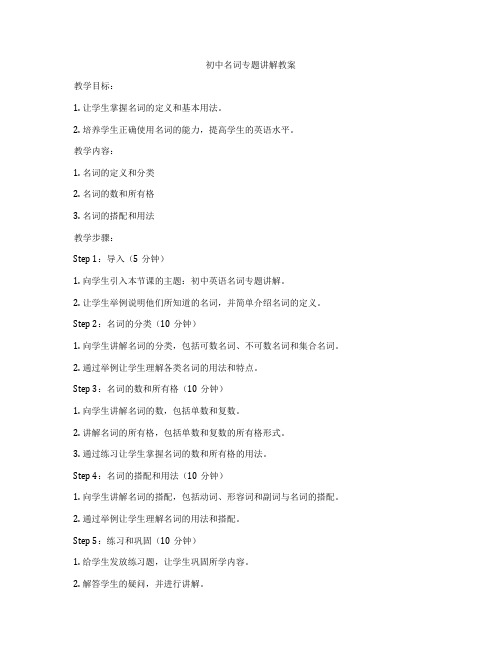
初中名词专题讲解教案教学目标:1. 让学生掌握名词的定义和基本用法。
2. 培养学生正确使用名词的能力,提高学生的英语水平。
教学内容:1. 名词的定义和分类2. 名词的数和所有格3. 名词的搭配和用法教学步骤:Step 1:导入(5分钟)1. 向学生引入本节课的主题:初中英语名词专题讲解。
2. 让学生举例说明他们所知道的名词,并简单介绍名词的定义。
Step 2:名词的分类(10分钟)1. 向学生讲解名词的分类,包括可数名词、不可数名词和集合名词。
2. 通过举例让学生理解各类名词的用法和特点。
Step 3:名词的数和所有格(10分钟)1. 向学生讲解名词的数,包括单数和复数。
2. 讲解名词的所有格,包括单数和复数的所有格形式。
3. 通过练习让学生掌握名词的数和所有格的用法。
Step 4:名词的搭配和用法(10分钟)1. 向学生讲解名词的搭配,包括动词、形容词和副词与名词的搭配。
2. 通过举例让学生理解名词的用法和搭配。
Step 5:练习和巩固(10分钟)1. 给学生发放练习题,让学生巩固所学内容。
2. 解答学生的疑问,并进行讲解。
Step 6:总结和作业布置(5分钟)1. 对本节课的内容进行总结,让学生掌握名词的定义、分类、数、所有格和搭配。
2. 布置作业,让学生巩固所学内容。
教学评价:1. 通过课堂讲解和练习,评价学生对名词的理解和掌握程度。
2. 通过课后作业,评价学生对名词知识的巩固情况。
教学资源:1. 名词讲解PPT。
2. 练习题。
教学建议:1. 在讲解名词的分类时,可以结合具体的例子进行讲解,让学生更好地理解。
2. 在讲解名词的数和所有格时,可以通过练习让学生掌握用法。
3. 在讲解名词的搭配和用法时,可以结合具体的句子进行讲解,让学生更好地理解。
以上就是关于初中英语名词专题讲解的教案,希望对您有所帮助。
初中英语名词教案
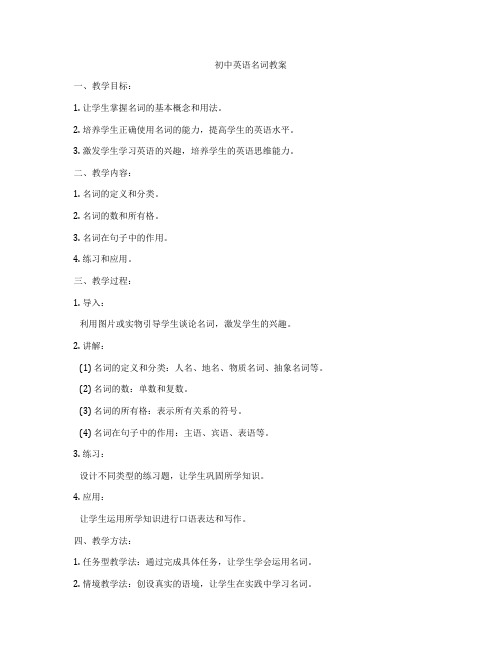
初中英语名词教案一、教学目标:1. 让学生掌握名词的基本概念和用法。
2. 培养学生正确使用名词的能力,提高学生的英语水平。
3. 激发学生学习英语的兴趣,培养学生的英语思维能力。
二、教学内容:1. 名词的定义和分类。
2. 名词的数和所有格。
3. 名词在句子中的作用。
4. 练习和应用。
三、教学过程:1. 导入:利用图片或实物引导学生谈论名词,激发学生的兴趣。
2. 讲解:(1) 名词的定义和分类:人名、地名、物质名词、抽象名词等。
(2) 名词的数:单数和复数。
(3) 名词的所有格:表示所有关系的符号。
(4) 名词在句子中的作用:主语、宾语、表语等。
3. 练习:设计不同类型的练习题,让学生巩固所学知识。
4. 应用:让学生运用所学知识进行口语表达和写作。
四、教学方法:1. 任务型教学法:通过完成具体任务,让学生学会运用名词。
2. 情境教学法:创设真实的语境,让学生在实践中学习名词。
3. 互动式教学法:鼓励学生积极参与,提高学生的学习积极性。
五、教学评价:1. 课堂参与度:观察学生在课堂上的发言和表现。
2. 练习正确率:检查学生完成练习题的正确率。
3. 应用能力:评估学生在口语表达和写作中的运用能力。
六、教学资源:1. 图片或实物:用于引导学生谈论名词。
2. 练习题:用于巩固所学知识。
3. 教学课件:辅助讲解和展示名词的相关知识。
七、教学时间:1课时(40分钟)八、课后作业:1. 复习名词的基本概念和用法。
2. 完成课后练习题。
3. 尝试在日常生活和学习中运用所学知识。
通过本节课的教学,使学生掌握名词的基本概念和用法,提高学生正确使用名词的能力,为后续学习打下基础。
同时,注重培养学生的英语思维能力,激发学生学习英语的兴趣。
中考英语名词专题复习教案

中考英语名词专题复习教案第一章:名词的分类和作用一、教学目标1. 掌握名词的分类:可数名词、不可数名词和集合名词。
2. 理解名词在句子中的作用:主语、宾语、表语等。
3. 学会正确使用名词修饰语。
二、教学内容1. 名词的分类及其特点。
2. 名词在句子中的功能。
3. 名词修饰语的用法。
三、教学重点与难点1. 名词分类的判断。
2. 名词在不同句子中的作用。
3. 名词修饰语的运用。
四、教学方法1. 实例分析法:通过具体例句讲解名词的分类和作用。
2. 练习法:设计相关练习题,巩固所学知识。
五、教学步骤1. 引入:讨论日常生活中遇到的名词,引出名词的分类和作用。
2. 讲解:讲解名词的分类、特点和在不同句子中的作用。
3. 练习:设计练习题,让学生判断名词的分类和作用。
第二章:名词所有格一、教学目标1. 掌握名词所有格的用法。
2. 学会正确使用名词所有格表示占有、来源、关系等。
二、教学内容1. 名词所有格的规则。
2. 名词所有格在句子中的表达方式。
3. 名词所有格的典型例句。
三、教学重点与难点1. 名词所有格的规则。
2. 名词所有格在句子中的表达。
四、教学方法1. 讲解法:讲解名词所有格的规则和用法。
2. 例句法:通过典型例句展示名词所有格的表达方式。
五、教学步骤1. 引入:讨论日常生活中涉及名词所有格的场景,引出名词所有格的用法。
2. 讲解:讲解名词所有格的规则和用法。
3. 练习:设计练习题,让学生运用名词所有格。
第三章:名词的数和格一、教学目标1. 掌握名词的数和格的变化规则。
2. 学会正确使用名词的数和格表示数量、归属等。
二、教学内容1. 名词的数的变化规则。
2. 名词的格的变化规则。
3. 名词的数和格在句子中的运用。
三、教学重点与难点1. 名词的数的变化规则。
2. 名词的格的变化规则。
四、教学方法1. 讲解法:讲解名词的数和格的变化规则。
2. 练习法:设计练习题,巩固所学知识。
五、教学步骤1. 引入:讨论日常生活中涉及名词数量的场景,引出名词的数和格。
英语名词教案怎么写初中
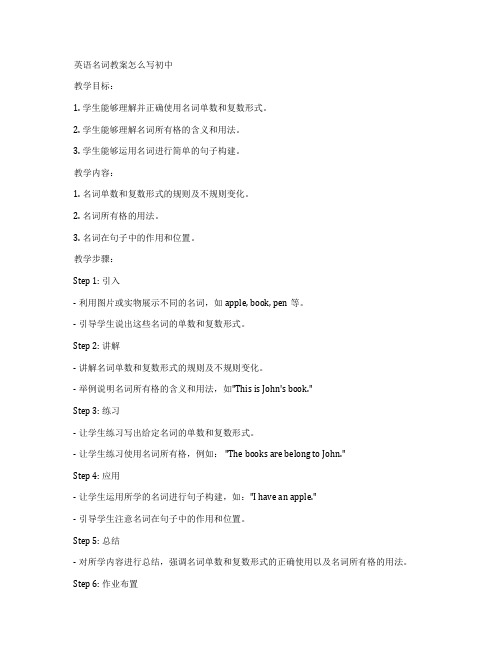
英语名词教案怎么写初中教学目标:1. 学生能够理解并正确使用名词单数和复数形式。
2. 学生能够理解名词所有格的含义和用法。
3. 学生能够运用名词进行简单的句子构建。
教学内容:1. 名词单数和复数形式的规则及不规则变化。
2. 名词所有格的用法。
3. 名词在句子中的作用和位置。
教学步骤:Step 1: 引入- 利用图片或实物展示不同的名词,如apple, book, pen等。
- 引导学生说出这些名词的单数和复数形式。
Step 2: 讲解- 讲解名词单数和复数形式的规则及不规则变化。
- 举例说明名词所有格的含义和用法,如"This is John's book."Step 3: 练习- 让学生练习写出给定名词的单数和复数形式。
- 让学生练习使用名词所有格,例如: "The books are belong to John."Step 4: 应用- 让学生运用所学的名词进行句子构建,如:"I have an apple."- 引导学生注意名词在句子中的作用和位置。
Step 5: 总结- 对所学内容进行总结,强调名词单数和复数形式的正确使用以及名词所有格的用法。
Step 6: 作业布置- 布置练习题,让学生巩固所学内容,如:填空题、选择题等。
教学评价:1. 通过课堂练习和作业,评估学生对名词单数和复数形式的掌握情况。
2. 通过句子构建练习,评估学生对名词所有格的运用能力。
3. 通过课堂讨论和问答,评估学生对名词在句子中作用和位置的理解程度。
教学资源:1. 图片或实物。
2. 练习题。
3. 教学PPT或黑板。
教学反思:在课后,教师应反思本次教学的效果,根据学生的反馈和表现,调整教学方法和策略,以提高学生的英语名词水平。
初中英语名词专项教案

初中英语名词专项教案一、教学目标:1. 让学生掌握名词的分类,包括可数名词、不可数名词和抽象名词。
2. 让学生学会使用名词的所有格形式,包括of所有格和's所有格。
3. 让学生能够正确使用名词修饰名词,构成名词短语。
4. 提高学生运用名词进行交际的能力。
二、教学内容:1. 名词的分类:可数名词、不可数名词和抽象名词。
2. 名词的所有格形式:of所有格和's所有格。
3. 名词修饰名词:中心名词和限定名词。
4. 名词短语的运用。
三、教学重点与难点:1. 重点:名词的分类、所有格形式和名词短语的运用。
2. 难点:名词的所有格形式和名词短语的运用。
四、教学方法:1. 任务型教学法:通过完成具体的任务,让学生学会运用名词进行交际。
2. 情境教学法:创设真实的语境,让学生在实际情境中学习名词。
3. 游戏教学法:通过有趣的游戏,激发学生的学习兴趣,巩固所学知识。
五、教学步骤:1. 引入:通过图片和实物,引导学生关注名词,激发学生的学习兴趣。
2. 讲解:讲解名词的分类,可数名词、不可数名词和抽象名词。
3. 练习:让学生区分不同类别的名词,进行练习。
4. 讲解:讲解名词的所有格形式,of所有格和's所有格。
5. 练习:让学生运用所有格形式,进行练习。
6. 讲解:讲解名词修饰名词,中心名词和限定名词。
7. 练习:让学生运用名词修饰名词,构成名词短语。
8. 讲解:讲解名词短语的运用,如何正确使用。
9. 练习:让学生在实际情境中,运用名词短语。
10. 总结:对本节课所学内容进行总结,让学生掌握名词的分类、所有格形式和名词短语的运用。
11. 作业布置:布置相关练习题,让学生巩固所学知识。
六、教学评估:1. 课堂参与度:观察学生在课堂活动中的参与程度,了解他们对名词知识的掌握情况。
2. 练习正确性:评估学生在练习中的正确率,检验他们对名词分类、所有格形式和名词短语的掌握程度。
3. 小组讨论:通过小组讨论的方式,了解学生在合作中的交流和运用名词的能力。
初中英语名词专项教案

初中英语名词专项教案一、教学目标1. 让学生掌握名词的分类,包括可数名词、不可数名词、名词所有格等。
2. 让学生学会名词的复数形式变化规则。
3. 培养学生正确使用名词表达日常生活中的事物和概念的能力。
二、教学内容1. 可数名词与不可数名词的区分及用法。
2. 名词所有格的用法。
3. 名词的复数形式变化规则。
4. 名词在句子中的作用和位置。
三、教学重点与难点1. 教学重点:名词的分类、名词所有格的用法、名词的复数形式变化规则。
2. 教学难点:名词所有格的用法、名词的复数形式变化规则。
四、教学方法1. 采用直观演示法,通过实物、图片等引导学生直观地认识名词。
2. 采用情景教学法,创设生活情境,让学生在实际语境中运用名词。
3. 采用任务型教学法,设计各种任务,让学生在完成任务的过程中巩固名词知识。
五、教学步骤1. 导入:通过展示生活中常见的实物,引导学生说出相应的名词,引出本课主题。
2. 讲解:讲解可数名词与不可数名词的区分及用法,举例说明。
3. 练习:让学生练习区分可数名词和不可数名词,并用它们造句。
4. 讲解:讲解名词所有格的用法,举例说明。
5. 练习:让学生练习使用名词所有格,并用它们造句。
6. 讲解:讲解名词的复数形式变化规则,举例说明。
7. 练习:让学生练习变化名词的复数形式,并用它们造句。
8. 总结:对本课内容进行总结,强调重点和难点。
9. 作业:布置相关练习题,让学生巩固所学知识。
10. 课后反思:对本课教学进行反思,总结经验教训。
六、教学评价1. 评价方式:采用课堂练习、课后作业、小组讨论等多种方式进行评价。
2. 评价内容:学生对名词的分类、名词所有格的用法、名词的复数形式变化规则的掌握程度以及名词在句子中的运用能力。
七、教学拓展1. 进行名词词义辨析活动,如给出几个名词,让学生选出正确的词义。
2. 进行名词填空练习,让学生在句子中填入适当的名词。
3. 进行名词用法讨论,让学生举例说明名词在句子中的不同作用。
初中英语名词专项教案
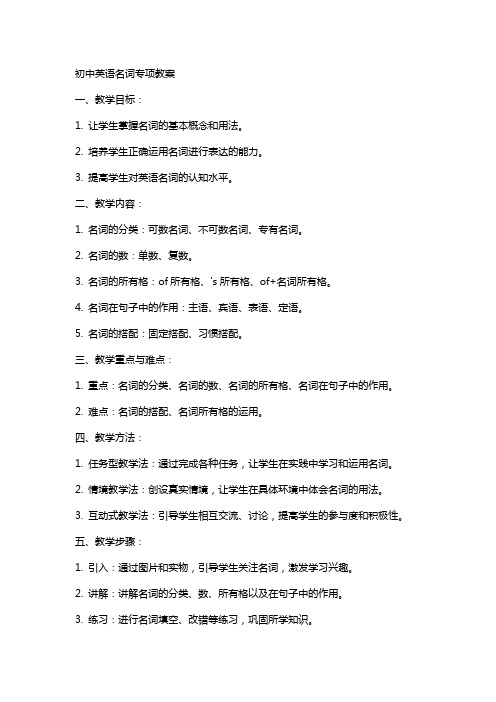
初中英语名词专项教案一、教学目标:1. 让学生掌握名词的基本概念和用法。
2. 培养学生正确运用名词进行表达的能力。
3. 提高学生对英语名词的认知水平。
二、教学内容:1. 名词的分类:可数名词、不可数名词、专有名词。
2. 名词的数:单数、复数。
3. 名词的所有格:of所有格、's所有格、of+名词所有格。
4. 名词在句子中的作用:主语、宾语、表语、定语。
5. 名词的搭配:固定搭配、习惯搭配。
三、教学重点与难点:1. 重点:名词的分类、名词的数、名词的所有格、名词在句子中的作用。
2. 难点:名词的搭配、名词所有格的运用。
四、教学方法:1. 任务型教学法:通过完成各种任务,让学生在实践中学习和运用名词。
2. 情境教学法:创设真实情境,让学生在具体环境中体会名词的用法。
3. 互动式教学法:引导学生相互交流、讨论,提高学生的参与度和积极性。
五、教学步骤:1. 引入:通过图片和实物,引导学生关注名词,激发学习兴趣。
2. 讲解:讲解名词的分类、数、所有格以及在句子中的作用。
3. 练习:进行名词填空、改错等练习,巩固所学知识。
4. 拓展:介绍名词的搭配,让学生学会正确运用。
5. 总结:对本节课内容进行总结,强调重点和难点。
6. 作业:布置相关练习,让学生课后巩固。
六、教学评估:1. 课堂互动:观察学生在课堂上的参与程度和积极性,评估他们对名词知识的理解和运用能力。
2. 练习完成情况:检查学生完成练习的情况,评估他们对名词知识的掌握程度。
3. 课后作业:审阅学生的课后作业,评估他们对名词知识的运用和拓展能力。
七、教学反思:1. 针对学生的学习情况,反思教学内容的难易程度是否适合学生。
2. 反思教学方法是否能够激发学生的学习兴趣和积极性。
3. 思考如何改进教学,以便更好地帮助学生掌握名词知识。
八、教学延伸:1. 进一步讲解名词的衍生词汇和短语,扩大学生的词汇量。
2. 通过阅读和写作活动,让学生在实际语境中运用名词知识。
初中英语名词专题教案

初中英语名词专题教案一、教学目标1. 让学生掌握名词的分类及特点,包括可数名词、不可数名词、名词所有格等。
2. 培养学生正确使用名词的能力,包括名词的单复数、名词短语的构成和运用。
3. 提高学生对名词在句子中的作用和语法的认识,如主语、宾语、表语等。
4. 加强学生的听说读写能力,通过各种练习和活动,使学生在实际语境中运用名词。
二、教学内容1. 名词的分类及特点2. 名词的单复数变化规则3. 名词所有格的用法4. 名词在句子中的作用5. 名词短语的构成和运用三、教学重点与难点1. 重点:名词的分类、单复数变化规则、名词所有格的用法、名词在句子中的作用。
2. 难点:名词短语的构成和运用,特别是固定搭配和习惯用法。
四、教学方法1. 采用交际法,通过情景设定和角色扮演,让学生在实际语境中运用名词。
2. 运用任务型教学法,分组讨论和完成任务,提高学生的合作能力和实际应用能力。
3. 运用直观教学法,通过图片、实物等展示名词,增强学生的感官认识。
4. 运用语法讲解法,清晰讲解名词的分类、单复数变化规则等,确保学生掌握基础知识。
五、教学准备1. 教学PPT,包含名词的分类、特点、单复数变化规则、名词所有格等知识点。
2. 教学素材,如图片、实物、例句等。
3. 练习题,包括选择题、填空题、翻译题等,用于巩固所学知识。
4. 分组任务,让学生在课堂上进行合作和讨论。
六、教学步骤1. 导入:通过展示一幅图片或一个实物,引导学生说出相应的名词,引出本课主题。
2. 讲解:详细讲解名词的分类、特点、单复数变化规则、名词所有格等基本知识。
3. 示例:给出典型例句,展示名词在句子中的不同作用,如主语、宾语、表语等。
4. 练习:让学生完成一些选择题、填空题等,检查他们对名词知识的掌握程度。
5. 活动:组织学生进行小组活动,如讨论、角色扮演等,让学生在实际语境中运用名词。
七、课堂练习1. 选择题:判断下列句子中画线名词的词性和作用。
2. 填空题:根据语境,填入适当的名词形式。
(完整版)初中英语名词经典教案

初三英语总复习名词教案★语法梳理 名词知识概要一、名词的分类car ——cars , student ——students , book ——books designer ——designersairplane ——airplanes water, bread, paper, tear,二、可数名词的复数形式1、名词按其所表示的事物的性质分为可数名词(Countable Noun)和不可数名词(Uncountable Noun),可数名词又有单数和复数两种形式。
练一练:把下面的名词变成它的复数形式season_______form________plan_________bus______watch_______tomato_________hobby_________ city__________ toy________ monkey________wife________leaf________ man________woman_______ sheep______mouse_________foot______man—men woman----women tooth----teeth foot---feetmouse----mice child----children deer---deer sheep---sheepChinese—Chinese Japanese—Japanesepoliceman-policemen(与man和 woman构成的合成词,其复数形式也是-men 和-women)Englishman———Englishmen Frenchman————Frenchmen(三)某国人变复数,记住以下的顺口溜:中日不变,英法改变,其他加sChinese——Chinese Japanese——JapaneseEnglishman———Englishmen Frenchman————FrenchmenAmerican———Americans(例外:German---Germans)(German不是合成词,故复数形式为 Germans)(五)表示复数的名词(复合名词)police(警察)Public (公众)family (家人)people(人们)the + 姓s 例:the Smiths 史密斯一家人注意:有些集体名词如family,team,class,police等表示一个整体时,谓语动词应用单数;表示各成员时,谓语动词应该用复数形式.练一练:My family _________(be) a big one. All my family _______be) in China now.(六)数词+名词作定语时,这个名词一般保留单数形式,中间加连字符.例如:ten-minute walk,an 8-year-old girl, a ten-mile walk(七) 看似复数实际是单数的名词:news 消息Politics 政治Maths 数学Physics 物理1. No news _______ good news. (be)2. I think maths _______ very important.(八)既可作可数又可作不可数的名词:chicken 小鸡 / 鸡肉room 房间 / 空间;位置work 作品/ 工作paper 论文; 报纸/ 纸glass 玻璃杯 / 玻璃time 次;倍 / 时间wood 树林 / 木头fish 鱼 / 鱼肉exercise 练习 / 运动;锻炼light 灯 / 光fruit (各种)水果 / 水果(九)常用不可数名词bread; meat; rice; food; water; tea; milk; coffee; juice; paper; Grass; news; advice; music; information; sugar; chocolate; jam;Hair; ice; rain; snow; sun; wind; work; help; love; hope; weather;(十)不可数名词"量"的表示方法.manya few 修饰可数名词a number ofmuch 修饰不可数名词a littlesome / a lot of 修饰可数/不可数名词不可数名词不能与数词连用,若要表示相应的数量,则需要借助一定的单位词1、借助表示“张”、“块”的单位词2、 a piece of paper 一张纸 a piece of music a piece of informationa piece of advice 一条建议 a piece of news 一条新闻 a piece of chalk 一支粉笔2.借助表示容量的词a bottle of ink 一瓶墨水 a cup of tea 一杯茶a bowl of rice 一碗米饭 a glass of beer 一杯啤酒3.借助表示重量的词a kilo of salt 一公斤盐 ten tons of coal 十吨煤4.借助表示形状的词a drop of water 一滴水 a grain of sand 一粒沙a cup of tea → two cups of teaa piece of paper → three pieces of paper三.名词所有格用来表示人或物的所有,以及领属关系。
初中生英语名词讲解教案

初中生英语名词讲解教案教学目标:1. 让学生掌握名词的定义和基本用法。
2. 让学生学会使用名词进行正确的句子构建。
3. 培养学生对英语名词的兴趣和理解能力。
教学内容:1. 名词的定义和分类。
2. 名词的数和格。
3. 名词在句子中的作用。
4. 练习和应用。
教学步骤:Step 1: 引入名词的概念- 向学生解释名词的定义,即表示人、事物、地点或抽象概念的词。
- 举例说明,如:boy, girl, book, table, happiness等。
Step 2: 名词的分类- 解释名词可以分为可数名词和不可数名词。
- 可数名词表示可以数的事物,如:apples, cars等。
- 不可数名词表示无法数的事物,如:water, air等。
Step 3: 名词的数- 讲解名词的复数形式,如:boy - boys, book - books等。
- 强调复数形式的变化规则,如: add - s, add - es, change y to i and add - es等。
Step 4: 名词的格- 讲解名词的格,包括主格、宾格和所有格。
- 主格表示名词作为主语,如:The book is interesting.- 宾格表示名词作为宾语,如:I read a book.- 所有格表示名词的所有权,如:This is my book.Step 5: 名词在句子中的作用- 讲解名词在句子中的不同作用,如主语、宾语、表语等。
- 举例说明,如:The cat (主语) is sleeping.I like (宾语) apples.He is a (表语) teacher.Step 6: 练习和应用- 提供一些练习题,让学生区分可数名词和不可数名词。
- 让学生尝试用名词构建句子,如:My brother is a student.- 鼓励学生进行小组讨论,用名词进行对话。
Step 7: 总结和复习- 对本节课的内容进行总结,强调名词的定义、分类、数和格的重要性。
初中英语名词教案简案模板

一、教学目标1. 知识目标:(1)学生能够正确识别和运用名词。
(2)学生能够理解名词的分类(普通名词、专有名词、抽象名词等)。
(3)学生能够区分可数名词和不可数名词。
2. 能力目标:(1)学生能够通过阅读和听力练习提高名词的运用能力。
(2)学生能够通过写作练习提高名词的运用和组合能力。
3. 情感目标:(1)激发学生学习英语的兴趣,培养他们对英语学习的自信心。
(2)培养学生良好的学习习惯和团队合作精神。
二、教学内容1. 名词的分类2. 可数名词和不可数名词的用法3. 名词的复数形式三、教学重点与难点1. 教学重点:(1)名词的分类和用法。
(2)可数名词和不可数名词的区分。
2. 教学难点:(1)名词复数形式的构成规则。
(2)名词在句子中的正确运用。
四、教学过程1. 导入通过展示一些生活中的名词图片或实物,引导学生思考名词的特点,激发学习兴趣。
2. 新课讲授(1)名词的分类:普通名词、专有名词、抽象名词等。
(2)可数名词和不可数名词的用法:举例说明可数名词和不可数名词的用法,如“a book”和“some water”。
(3)名词复数形式:讲解名词复数形式的构成规则,如规则变化和不规则变化。
3. 练习环节(1)听写练习:学生听录音,写出正确的名词。
(2)选择题:学生根据题意,选择正确的名词填空。
(3)翻译练习:将中文句子翻译成英文,注意名词的正确运用。
4. 小组活动将学生分成小组,进行名词分类和用法的小组讨论,每组派代表分享讨论结果。
5. 总结与作业(1)教师总结本节课所学内容,强调重点和难点。
(2)布置课后作业,如完成名词相关的练习题、阅读课文等。
五、教学评价1. 课堂表现:观察学生在课堂上的参与度、积极性。
2. 作业完成情况:检查学生的课后作业,了解学生对名词的掌握程度。
3. 小组活动表现:评估学生在小组活动中的表现,如团队合作、分享交流等。
六、教学反思1. 课堂气氛是否活跃,学生参与度如何。
2. 教学内容是否清晰,重点难点是否突出。
初中英语名词专项解读教案
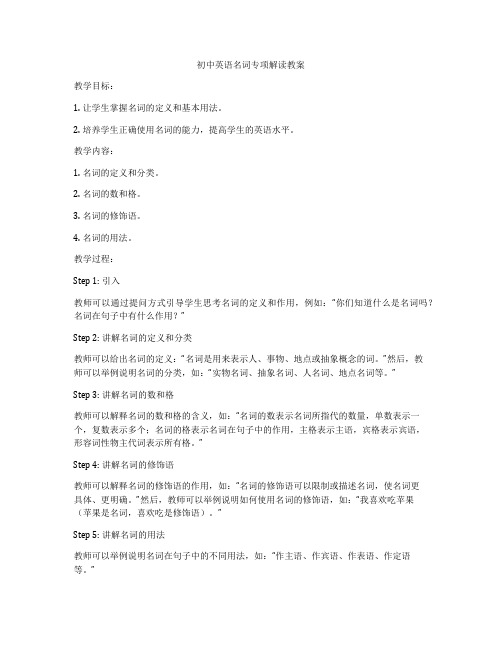
初中英语名词专项解读教案教学目标:1. 让学生掌握名词的定义和基本用法。
2. 培养学生正确使用名词的能力,提高学生的英语水平。
教学内容:1. 名词的定义和分类。
2. 名词的数和格。
3. 名词的修饰语。
4. 名词的用法。
教学过程:Step 1: 引入教师可以通过提问方式引导学生思考名词的定义和作用,例如:“你们知道什么是名词吗?名词在句子中有什么作用?”Step 2: 讲解名词的定义和分类教师可以给出名词的定义:“名词是用来表示人、事物、地点或抽象概念的词。
”然后,教师可以举例说明名词的分类,如:“实物名词、抽象名词、人名词、地点名词等。
”Step 3: 讲解名词的数和格教师可以解释名词的数和格的含义,如:“名词的数表示名词所指代的数量,单数表示一个,复数表示多个;名词的格表示名词在句子中的作用,主格表示主语,宾格表示宾语,形容词性物主代词表示所有格。
”Step 4: 讲解名词的修饰语教师可以解释名词的修饰语的作用,如:“名词的修饰语可以限制或描述名词,使名词更具体、更明确。
”然后,教师可以举例说明如何使用名词的修饰语,如:“我喜欢吃苹果(苹果是名词,喜欢吃是修饰语)。
”Step 5: 讲解名词的用法教师可以举例说明名词在句子中的不同用法,如:“作主语、作宾语、作表语、作定语等。
”Step 6: 练习教师可以设计一些练习题,让学生运用所学的名词知识,如:“用所给的名词造句、选择正确的名词形式等。
”Step 7: 总结教师可以总结本节课所讲的内容,并强调名词的重要性和用法,如:“名词是英语中常用的词性之一,掌握名词的用法对于提高英语水平非常重要。
”Step 8: 作业教师可以布置一些作业,让学生巩固所学的名词知识,如:“写一篇短文,运用所学的名词知识。
”教学评价:1. 观察学生在课堂上的参与程度和理解程度。
2. 检查学生的练习和作业,看是否能够正确使用名词。
教学反思:教师可以在课后反思本节课的教学效果,看是否达到了预期的教学目标,如:“学生是否掌握了名词的定义和分类、名词的数和格、名词的修饰语和用法等。
初中英语名词专题教案

初中英语名词专题教案一、教学目标1. 让学生掌握名词的分类,包括可数名词、不可数名词和集体名词。
2. 让学生学会名词的所有格形式,包括of所有格和's所有格。
3. 让学生能够正确运用名词修饰名词,构成名词短语。
4. 提高学生运用英语进行交际的能力。
二、教学内容1. 名词的分类:可数名词、不可数名词和集体名词。
2. 名词的所有格形式:of所有格和's所有格。
3. 名词修饰名词:构成名词短语。
三、教学重点与难点1. 教学重点:名词的分类、名词的所有格形式以及名词修饰名词的用法。
2. 教学难点:名词的所有格形式和名词修饰名词的运用。
四、教学方法1. 任务型教学法:通过完成各种任务,让学生在实践中学习和掌握名词的用法。
2. 情景教学法:创设各种真实的语境,让学生在语境中学习名词的分类和用法。
3. 互动式教学法:引导学生参与课堂讨论,提高学生的积极性和主动性。
五、教学步骤1. 导入:通过展示图片,引导学生说出图片中的名词,引出本课主题。
2. 讲解:讲解名词的分类,可数名词、不可数名词和集体名词的概念及用法。
3. 练习:让学生完成名词分类的练习题,巩固所学知识。
4. 讲解:讲解名词的所有格形式,包括of所有格和's所有格的用法。
5. 练习:让学生完成名词所有格形式的练习题,巩固所学知识。
6. 讲解:讲解名词修饰名词的用法,引导学生学会构成名词短语。
7. 练习:让学生完成名词修饰名词的练习题,巩固所学知识。
8. 总结:对本课内容进行总结,强调重点和难点。
9. 作业:布置课后作业,让学生巩固所学知识。
10. 拓展:引导学生运用所学知识进行实际交际,提高运用能力。
六、教学评估1. 课堂练习:通过实时练习,观察学生对名词分类、所有格形式以及名词修饰名词的掌握情况。
2. 课后作业:布置相关的习题,要求学生在课后完成,以巩固所学知识。
3. 口语表达:在课堂上提供机会让学生运用所学知识进行口语表达,评估他们的实际应用能力。
初中英语语法名词教案

初中英语语法名词教案教学目标:1. 掌握名词的分类和作用。
2. 学会名词的所有格形式。
3. 能够正确使用名词进行句子构建。
教学内容:1. 名词的分类:可数名词、不可数名词、集合名词。
2. 名词的所有格形式:of所有格、's所有格、of's所有格。
3. 名词在句子中的运用。
教学步骤:Step 1: 引入教师通过展示一些图片,让学生猜测这些图片所代表的名词,从而引出本节课的主题——名词。
Step 2: 讲解1. 教师讲解名词的分类:可数名词、不可数名词、集合名词。
可数名词:表示可以数的事物,如:boy, girl, book, pen等。
不可数名词:表示不能数的事物,如:water, rice, air, soil等。
集合名词:表示由若干个体组成的事物,如:family, class, team等。
2. 教师讲解名词的所有格形式:of所有格:表示属于的关系,如:the book of Tom。
's所有格:表示属于的关系,如:Tom's book。
of's所有格:表示属于的关系,如:the book of Tom's。
Step 3: 练习1. 学生分组,每组选出一个名词,讨论这个名词的分类和所有格形式,然后向其他小组展示。
2. 教师给出一些句子,让学生判断其中的名词分类和所有格形式是否正确。
Step 4: 应用1. 学生根据所学知识,编写一些含有名词的句子。
2. 学生进行角色扮演,用所学的名词和所有格形式进行对话。
Step 5: 总结教师对本节课的内容进行总结,强调名词的分类和所有格形式的重要性。
Step 6: 作业学生回家后,用所学的名词和所有格形式编写一篇短文。
教学评价:1. 观察学生在课堂上的参与程度,了解他们对名词分类和所有格形式的掌握情况。
2. 检查学生作业中的短文,评估他们运用名词和所有格形式的能力。
3. 在下一节课开始时,让学生进行名词的分类和所有格形式的测试,以便了解他们的学习效果。
初中英语名词教案25篇范文

初中英语名词教案25篇范文第一篇:初中英语名词教案2第一章名词3.不可数名词a.不可数名词包括:物质名词waterpaper milk 抽象名词ability power youth 液体气体全都是不可数名词b.物质名词的数量表达方法①some , any , much , little , a little +物质名词some water 一些水②数词+表示容器的名词+of+物质名词a glass of water 一杯水two glasses of water 两杯水变复数是改量词并把容器名词变为复数a piece of paper 一张纸two pieces of paper 两张纸c,名词所有格(…的…)。
’s ①生物名词所有格名词+’s +名词a boy’s pena girl’s dress若第一个名词是以s结尾,则只加‘class’dress’②非生物所有格,用of连接the legs of the chair 椅子腿③双重所有格Ⅰ.of +生物所有格或名词性物主代词a bottle of mine a book of my father’sⅡ.双重所有格的使用场合1)当被修饰名词前有指示代词、疑问代词、不定代词或数词等限定词时,一般要用双重所有格I don’t like that big nose of David’s.我不喜欢大卫的那个大鼻子。
Which novel of Dicken’s are you referring to? 你谈的是狄更斯的哪部小说?Some friends of my brother’s will come,我兄弟的一些朋友要来。
注意:被双重所有格修饰名词前有指示代词时,通常带有一定的感情色彩。
(如赞赏、不满、厌恶等)That little daughter of your cousin’s is really a dear.你表哥的那个小女儿真是逗人爱。
- 1、下载文档前请自行甄别文档内容的完整性,平台不提供额外的编辑、内容补充、找答案等附加服务。
- 2、"仅部分预览"的文档,不可在线预览部分如存在完整性等问题,可反馈申请退款(可完整预览的文档不适用该条件!)。
- 3、如文档侵犯您的权益,请联系客服反馈,我们会尽快为您处理(人工客服工作时间:9:00-18:30)。
初三英语总复习名词教案★语法梳理名词知识概要一、名词的分类car ——cars ,student ——students ,book——books designer——designers airplane——airplanes water, bread, paper, tear,二、可数名词的复数形式1、名词按其所表示的事物的性质分为可数名词(Countable Noun)和不可数名词(Uncountable Noun),可数名词又有单数和复数两种形式。
练一练:把下面的名词变成它的复数形式season_______form________plan_________bus______watch_______tomato_________hobby_________ city__________ toy________ monkey________wife________leaf________ man________woman_______ sheep______mouse_________foot______man—men woman----women tooth----teeth foot---feetmouse----mice child----children deer---deer sheep---sheepChinese—Chinese Japanese—Japanesepoliceman-policemen(与man和 woman构成的合成词,其复数形式也是-men 和-women)Englishman———Englishmen Frenchman————Frenchmen(三)某国人变复数,记住以下的顺口溜:中日不变,英法改变,其他加sChinese——Chinese Japanese——JapaneseEnglishman———Englishmen Frenchman————FrenchmenAmerican———Americans(例外:German---Germans)(German不是合成词,故复数形式为 Germans)(五)表示复数的名词(复合名词)police(警察)Public (公众)family (家人)people(人们)the + 姓s 例:the Smiths 史密斯一家人注意:有些集体名词如family,team,class,police等表示一个整体时,谓语动词应用单数;表示各成员时,谓语动词应该用复数形式.练一练:My family _________(be) a big one. All my family _______be) in China now.(六)数词+名词作定语时,这个名词一般保留单数形式,中间加连字符.例如:ten-minute walk,an 8-year-old girl, a ten-mile walk(七) 看似复数实际是单数的名词:news 消息Politics 政治Maths 数学Physics 物理1. No news _______ good news. (be)2. I think maths _______ very important.(八)既可作可数又可作不可数的名词:chicken 小鸡 / 鸡肉room 房间 / 空间;位置work 作品/ 工作paper 论文; 报纸/ 纸glass 玻璃杯 / 玻璃time 次;倍 / 时间wood 树林 / 木头fish 鱼 / 鱼肉exercise 练习 / 运动;锻炼light 灯 / 光fruit (各种)水果 / 水果(九)常用不可数名词bread; meat; rice; food; water; tea; milk; coffee; juice; paper; Grass; news; advice; music; information; sugar; chocolate; jam;Hair; ice; rain; snow; sun; wind; work; help; love; hope; weather;(十)不可数名词"量"的表示方法.manya few 修饰可数名词a number ofmuch 修饰不可数名词a littlesome / a lot of 修饰可数/不可数名词不可数名词不能与数词连用,若要表示相应的数量,则需要借助一定的单位词1、借助表示“张”、“块”的单位词2、 a piece of paper 一张纸 a piece of music a piece of informationa piece of advice 一条建议 a piece of news 一条新闻 a piece of chalk 一支粉笔2.借助表示容量的词a bottle of ink 一瓶墨水 a cup of tea 一杯茶a bowl of rice 一碗米饭 a glass of beer 一杯啤酒3.借助表示重量的词a kilo of salt 一公斤盐 ten tons of coal 十吨煤4.借助表示形状的词a drop of water 一滴水 a grain of sand 一粒沙a cup of tea → two cups of teaa piece of paper → three pieces of paper三.名词所有格用来表示人或物的所有,以及领属关系。
表示有生命的名词的所有格其单数形式是加's其复数形式是s',如其结尾不是s的复数形式仍加's,如:a student's room, students' rooms, Children's Day.在表示时间、距离、世界、国家……名词的所有格要用's,如:a twenty minutes' walk.但无生命名词的所有格则必须四、名词的用法1、作主语English is useful. 英语很有用。
2、作定语:名词作定语,一般用单数形式paper tiger 纸老虎work place 工作的地方3、作宾语She learns English hard every day. 她天天努力学英语。
4、做表语Tom is my good friend. 汤姆是我的好朋友。
5、作宾语补足语They chose the boy monitor. 他们选那个男孩当班长。
1.练一练:把下面的名词变成它的复数形式season_______form________plan_________bus______watch_______tomato_________hobby_________ city__________ toy________ monkey________wife________leaf________ man________woman_______ sheep______mouse_________foot______2.选择:1. Some of the foreign friends are________,the others are________.A.Japanese;GermansB.Japanese;GermenC.Japaneses;Germans2.Three______are eating the grass at the foot of the mountain.A .sheeps B. sheep C .sheepes D. ships3.________teachers in their school is about 200 and one fourth of them are ________teachers.A.A number of;womenB.A number of; womanC.The number of; women4.We can see two________in the picture.A .apple tree B.apples trees C. apple trees D. apples tree5.Good news.We will have a _______holiday,I have heard of it, But it's coming in_______A.three days;three daysB.three days';three days'C.three-day;three days6.A computer is one of the greatest_______in this century.A、inventor B. inventions C. invention7.________went to Japan yesterday.A.The White'sB.The WhitesC.The White8、Mr Black gave us ______on how to learn English well.A.an adviceB.many advicesC.some adviceD.some advices3.填空:1.My family _________(be) a big one. All my family _______be) in China now.2.No news _______ good news. (be)3. I think maths _______ very important.4.选择:1.The young woman is ________English teacher.A Mary's and Lily B. Mary's and Lily's C.Mary and Lily's2.Her uncle feels happy because he heard from_________A. a old friend of himB. an old friend of hisC.an old friend of him3、With whom did you watch 2010 World Cup Opening Ceremony ?—_________.A.A friend of mineB. A friend of meC. A friend of my sister4. September 10th is ___Day.A TeacherB TeachersC Teacher'sD Teachers'5. June 1st is___.A. Children's dayB. children's Day C .Children's Day D. children's day综合大练习一、单选题1. Lucy and Lily___in the same class.A. amB. isC. areD. be2. Which is the ___to the bus stop, please?A roadB wayC streetD address3. Hurry up!There is___ time left.A littleB a littleC fewD a few4. How many ___can you see in the picture?A tomatosB tomatoesC tomatoD the tomato5. - ___is the meat. Please?- Ten yuan a kilo.A How muchB How manyC How oldD How long6 The boy's name is James Allen Green. So his given name is___.A James AllenB Allen GreenC James GreenD Mr. Green7 Shanghai is one of the biggest___in our country.A cityB city'sC citysD cities8 Would you please pass me___?A two paperB two papersC two pieces of paperD two pieces of papers9 Tony is a friend of___.A. Mary's mother'sB.mother of Mary'sC. Mary mother's10 I only have___ bread for lunch today.A a bitB a bit ofC littleD few11 "What would you like, Ann? ""I'd like two___."A glass of milkB glasses of milkC glass of milksD glasses of milks12 There isn't ___ paper in the box. Will you go and get ___ for me?A any, someB any, anyC some, someD some, any13. Is this your room?No, It's______roomA. the childrenB. the children's C . the childrens'14 These foreign friends are___.A GermanB GermenC GermanyD Germans15 All the students are busy, so___ of them will go to the cinema.A manyB littleC a fewD few16 There are three___and seven___in the picture.A deers, sheepsB deers, sheepC deer, sheep Ddeer, sheeps17 Whose room is this? It's___.A myB Kike's and John'sC ourD Kike and John's二、改错题1、Please give me a paper.2、My glasses is broken.3、I want to buy two shoes.4、May I borrow two radioes?5、There are much people in the garden.6、I want a few water.7、Don't eat too much meats.8、We have five German in this meeting.9、We have many woman teachers in our school.10、Physics are very difficult to learn.配电岗位本科面试题第一章必答题必答题11.试述架空线路维护应具备哪些技术资料?答:1)技术规程:电气装置安装工程施工及验收规范、架空配电线路运行规程、电力变压器运行规程、电力设施保护条例、电业安全工作规程。
